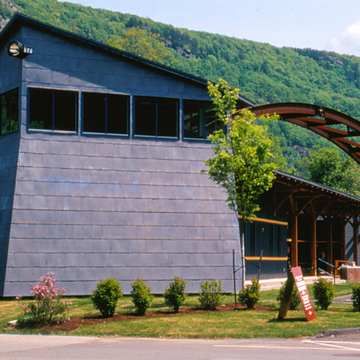In its form and materials the Waypoint Visitors' Center, on the Island and adjacent to canal and rail lines, utilizes deconstructivist design and architectural symbolism to allude to the town's history as a dynamic transportation center and water/railroad interface. Daniel V. Scully of Keene, New Hampshire, created a sculptural and expressive building focused on a slate-covered head piece that combines a cow-catcher-angled face, horizontal band of driver's windows, single headlamp, and a rearward sloping shed roof that together imply potential movement along masonry “rails” drawn in the lawn. A timber and iron railroad station, including a waiting room, freight room, and canopied platform, trails behind this form. It is sliced at an angle by a thirty-five-foot-high, one-hundred-and-fifty-foot-long pair of joined steel arches that pay homage to a lost Bellows Falls landmark. The Arch Bridge was built across the Connecticut River in 1905 as the longest arch suspension bridge in the United States and became famous as “the bridge that wouldn't die” when it resisted days of demolition blasting after being declared unsound in 1982. The result is an inspired study in whimsy, nostalgia, and sophisticated form.
You are here
Waypoint Visitors' Center
If SAH Archipedia has been useful to you, please consider supporting it.
SAH Archipedia tells the story of the United States through its buildings, landscapes, and cities. This freely available resource empowers the public with authoritative knowledge that deepens their understanding and appreciation of the built environment. But the Society of Architectural Historians, which created SAH Archipedia with University of Virginia Press, needs your support to maintain the high-caliber research, writing, photography, cartography, editing, design, and programming that make SAH Archipedia a trusted online resource available to all who value the history of place, heritage tourism, and learning.






